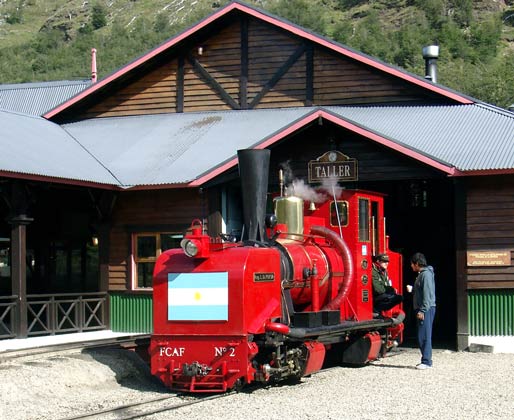
Visit to the Ferrocarril Austral Fueguino (FCAF) 500mm Gauge Railway, Ushuaia, Tierra del Fuego, Argentina January 2004
I visited FCAF, otherwise known as ‘The Train at the End of the World’ from January 14 2004 to January 21 2004. I was invited by the lines’ British born ‘Technical & Technical Projects Manager’ Shaun McMahon and thus was able to gain access to all areas of this very interesting, busy and successful 100% commercial operation.
Locomotives in service were:
No.2
‘Ing. L.D.Porta’ 0-4-0+0-4-0, built Argentina 1994,
rebuilt and modified at FCAF 2001. |
 |
No.3
‘Camila’ 2-6-2t, built 1995 Winson, Daventry, UK,
since modified at FCAF. |
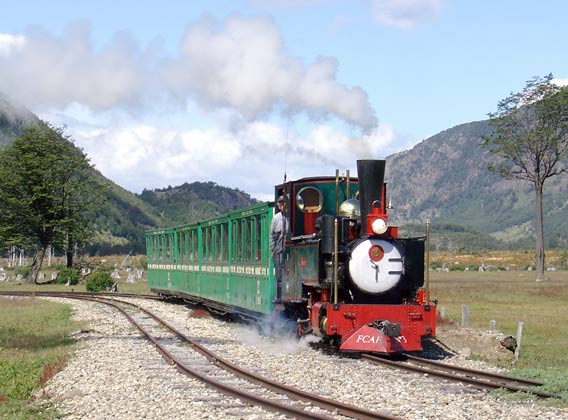 |
No.4
‘Tierra del Fuego’ 0-6-0DM, built 1999 Barries Engineering/Girdlestone
Rail, Port Shepstone, South Africa. |
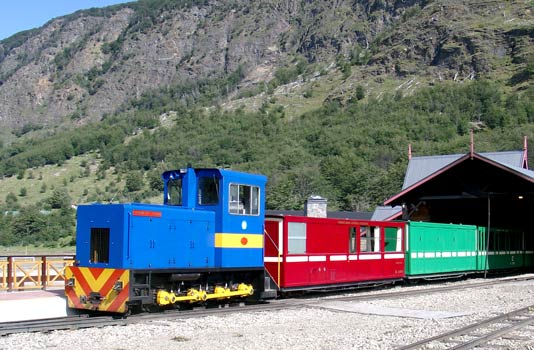 |
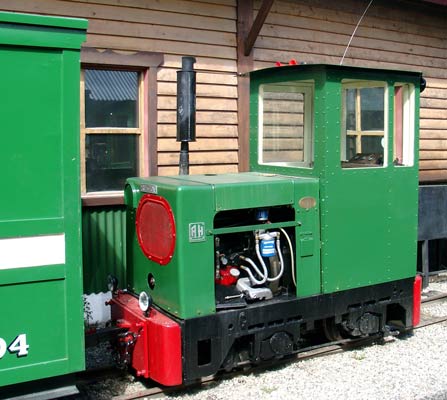 |
Locomotive
No.1 ‘Rodrigo’ 0-6-0DM built by Orenstein & Koppel 1938
was away being overhauled by a firm in Mar del Plata. No.1 has been out
of service since the intermediate driving axle broke in service during
November 1999 whilst locomotive No.5 (a Ruston/Hornsby 1960's built LBT
type) was nearing the end of an extensive overhaul having been withdrawn
from traffic during 1999. |
The line was at its’ busiest being the Argentine summer with many tourists in the area and a regular supply of passengers from incoming cruise liners.
The line has two publicly accessible stations – at the Ushuaia end is ‘Estación del Fin del Mundo’ (The Station at the End of the World) and within the Parque Nacional Tierra del Fuego is the end of the line at ‘Estación Parque National’.
Departures are very much dependant on pre-booked passenger numbers with several extra trains running on ‘boat train’ days. On such days both steam locomotives would be busy and the diesel was also to be found on passenger service. A normal day saw at least 500 passengers carried, with over 600 carried on ‘boat train’ days. Currently the line carries in the region of 55,000 passengers a year and operates every day of the year. 2003 has seen the highest passenger figures to date and are rising inline with predictions. The proprietor, Sñr Quique Diaz, and his staff are planning for 200,000 passengers a year in 10 years time.
The normal pattern of work is for both steam locomotives to be in traffic with No.2 handling the 09:15 departure from ‘Estación del Fin del Mundo’ on all days I was there. No.3 was left to haul the 09:30 relief which runs as required.
The vast majority of passengers travel only one way being picked up by tour buses to continue their itinerary, normally into Parque Nacional Tierra del Fuego. However some tours are arranged with the train journey as the return leg of the tour. One train run to cater for such demand is the 12:20 conditional from ‘Estación Parque Nacional’.
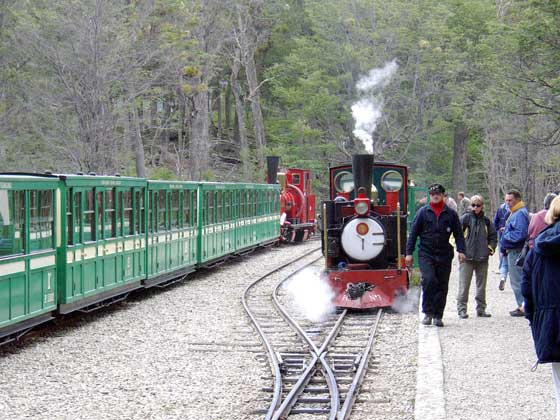 |
Two
trains at Estación Parque Nacional. On the left No.2 waits to form
the 12:20 to Estación del Fin del Mundo whilst No.3 has just arrived
with an extra train made up of just two carriages. January 16 2004 |
The other departures running from ‘Estación del Fin del Mundo’ are the 12:00 (conditional), 15:00 (non-conditional) and the 17:00 (conditional). On only one occasion did the 17:00 run.
Trains are normally loaded heavily with No.2 regularly hauling 8 or 9 carriage trains, something this rebuilt loco does with ease. It should be noted before rebuilding (when named ‘Nora’) it would struggle with more than 6 carriages. On test with all the lines stock it has proved impossible to work to stall the engine on the 1 in 22 Macarena Bank!
No.3 can haul 7 carriages unassisted as far as ‘La Macarena’ and 10 carriages from that station onwards on the outward journey and 10 on the less steeply graded return. However at the time of my visit trains 7 carriages or longer were banked by No.4 due to speed restrictions at the bottom of Macarena Bank preventing a run being taken at the bank. After ‘La Macarena’ station (the top of the bank) No.3 runs unassisted with No.4 returning to ‘Estación del Fin del Mundo.’
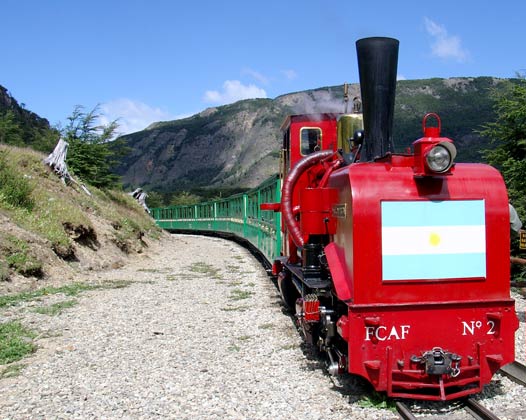 |
No.2
at ‘La Macarena’ with a typically lengthy 15:00 departure
ex-‘Estación del Fin del Mundo.’ January 16 2004 |
When not required for line work No.4 acts as station pilot. It also hauls the toilet coach out to ‘Estación Parque Nacional’ at the start of the day. Depending on traffic and loads this toilet coach is either retrieved by No.4 at the end of the day or is coupled to the last return working.
It should be emphasised that the operation runs like clockwork on the minimum of resources. Since modification the oil fired steam locomotives have proved very reliable and much more suited to their roles. The ease of operation was marked with very little time needed for preparation or disposal. Essentially this can be attributed to solid detail design that has been carried out thoughtfully and at a level appropriate to the lines’ location and facilities.
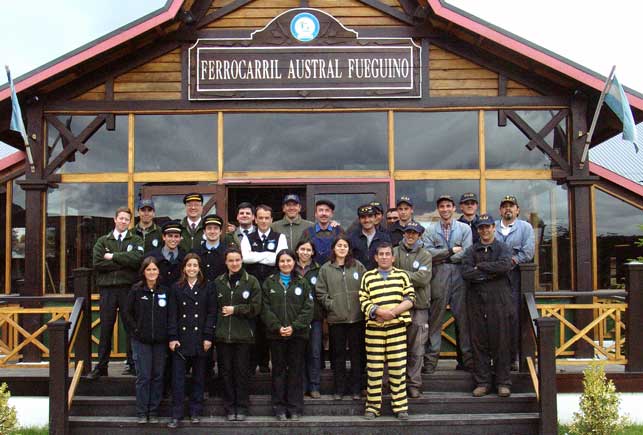
Most, but not all, of FCAF's staff for the summer 2003/04 season. January 18 2004
Commercially the line has also been considerably enhanced in the last few years with the introduction of computerised ticketing and management systems under Commercial Director Sñr Ruben Diaz. Considerable improvements to passenger facilities before and after boarding the trains have recently taken place.
On Saturday January 17 No.3 was stopped for a boiler washout and mechanical exam, this work being programmed for a quieter day but none the less it meant No.4 had to be employed on passenger service. The railway uses ‘Porta Treatment’ on its water supply (the local river.) The great success of this treatment regime is shown by the fact this was the first washout for No.3 in six months of daily use. The washout, a hot washout as per US steam practice, revealed no hard packed mud or sludge requiring removal. All the sludge washed out was fully mobile. Nothing was adhering to the internal boiler plates. A degree of scale was washed out but this did not have to be removed with rods, rather it was loose in the boiler, the removal of scale from the surfaces being one effect of the treatment. Most of the scale removed comes from the time when the locomotive was not on ‘Porta Treatment’. There was virtually no sign of corrosion internally. Some of the boiler surfaces are starting to acquire a grey appearance which shows they are totally clean and protected against corrosion.
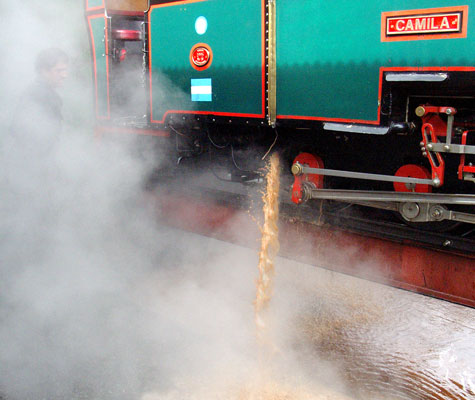 |
This railway uses 'Porta Treatment' in the locomotive boilers. The success of this very simple treatment regime is underlined by several key facts: 1.
This was the first washout in SIX MONTHS of
daily use with only 4 short blow downs in that period. |
Looking to the future the first 2 of 4 new standard carriages have arrived on the line and will be available for service shortly. Work is very much in hand on the detail planning for the extension of the line right up to the water front in the city of Ushuaia. This work is to be undertaken in stages, hopefully to be completed sometime in 2006. It is likely much or all of this extension will be laid as double track thus making operations much easier. Unlike the current line the extension will largely follow a totally new alignment rather than the old prison railway route, which has now been turned into roads or built on over considerable sections. It is also felt there will be fewer objections to the return of the line to the city if the new alignment avoids major areas of housing at much as possible. Finally, for now, work has started in earnest on the design of a third steam locomotive, No.6, which will probably be the prototype for the extra machines required to handle traffic on the extension. The 150hp locomotive will be a 2-6-2 based on the size and format of the current No.3 but built to modern standards of thermal efficiency and mechanical ruggedness. It is hoped to have this locomotive in service at the start of 2005.
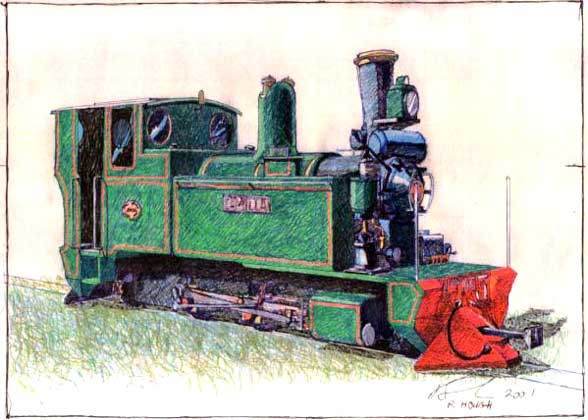 |
This
illustration of 'Camila' shows how the locomotive may approximately look
after further (stage 2) rebuilding. Whilst, in light of experience with
the loco, certain features will be different now this view is also a good
guide as to the likely appearance of the soon to be built FCAF No.6. Courtesy
of Shaun McMahon. |
I received a great deal of help and kindness from a number of people before and during my trip. Without their help it would not have been the success it was and I would not have had such a great time. So I would like to sincerely thank the following people:
Mr S.McMahon & Sra M.Galli-McMahon, Mr C.Parrott & ALL the staff of FCAF Ushuaia.
January
2004
© Martyn Bane. All Rights Reserved